15 Product Photography Ideas to Show Your Products in the Best Light (+ Examples)
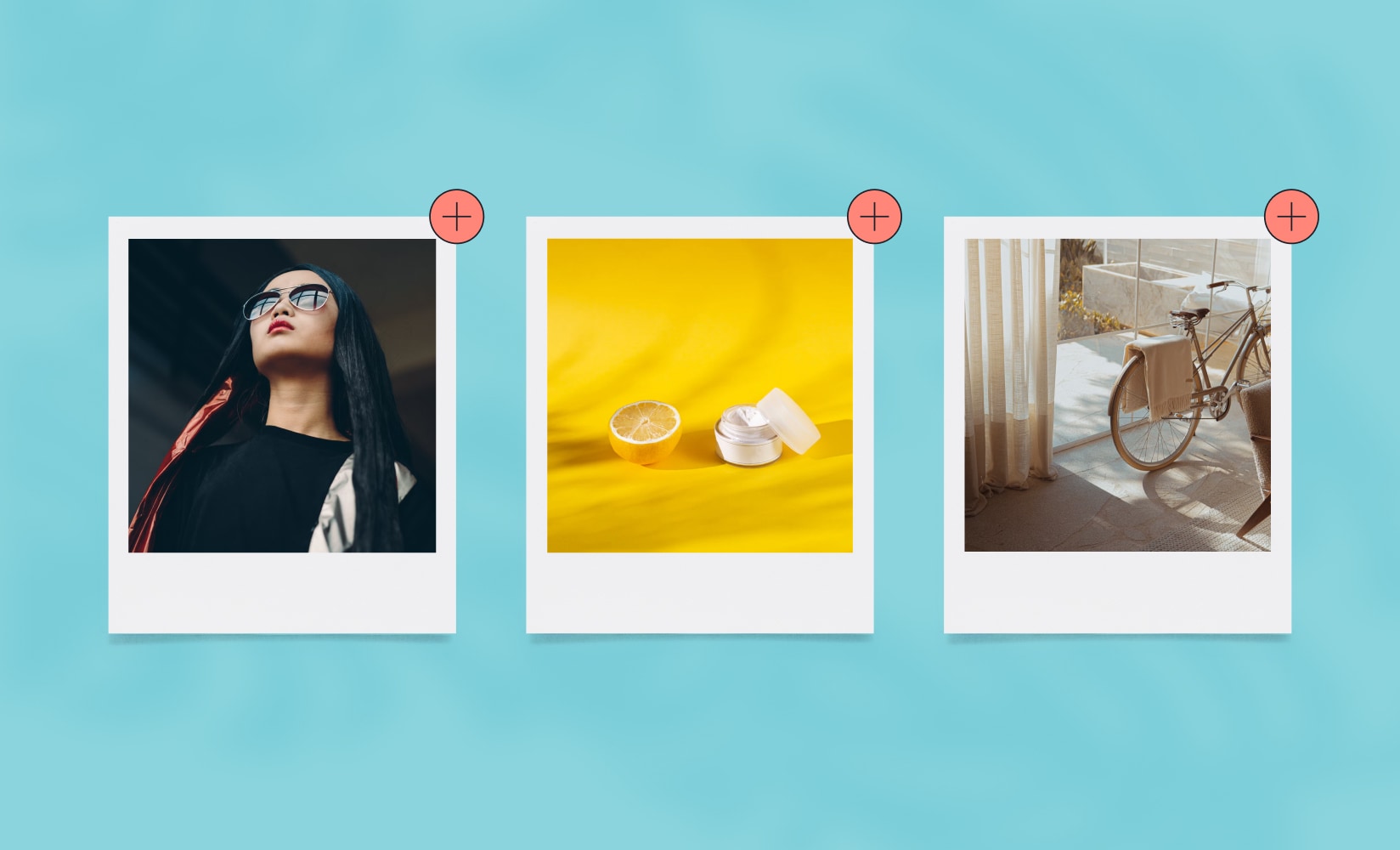
Your products are the stars of your ecommerce store. Without them, your website would be nothing (no matter how nice it looks).
So, you have to treat your products like the celebrities they are by putting them on a (literal) pedestal and taking indulgent photos of them from every angle. They deserve nothing less.
You do this to benefit the other star of your store—the potential customer.
Deciding whether or not they want to hand you their money, the shoppers want to be dazzled by your products and convinced that they need them in their lives.
So, you get out your fancy camera and your box of props and you get snapping.
To make your job easier, we’re going to detail lots of tricks for making your photos (and the products they depict) look incredible. Since there are so many amazing stores built with Shogun Page Builder, we only used examples from Shogun brands.
Let’s get into it.
#cta-visual-pb#<cta-title>Add gorgeous photos anywhere on your store<cta-title>Customize store pages quickly and include your product photos throughout your store to drive conversions.Customize faster with Shogun
15 product photography ideas to excite your shoppers (with examples)
A product photo is more than just an image of your goods on a table.
That product has life and energy. It yearns to show the world its many sides so they can imagine it in their lives.
So, let’s talk about some product photography ideas you can use to make those images go from ordinary to extraordinary.
Get symmetrical
Humans are built to recognize symmetry. It symbolizes balance and in photos, it draws attention to the subject at the center.
Symmetry in photography is created when two sides mirror each other to some degree.
In the images below from Brevitē, both figures are standing at the center of symmetrical architecture, framing them and the product at the center.
The images show the backpack in proportion to the male and female models and the models in proportion to their surroundings.

They use these images on their product pages to help shoppers make an informed purchasing decision.
Build a fitting scene
Your products don’t exist in isolation. They are connected to a purpose and to a story.
For some products, the story is simple—a scene depicting the product with a model and props, showing how it will be used and where.
For other products, the stories come first (or simultaneously), inspiring what the product will be and how shoppers are introduced to it.
In the case of East Fork, their ceramic collections are emphasized by the glazes they use. In this example, their newest glaze Utah is represented by the deserts and red rocks of that state.
When customers buy it, they are buying the visual story that comes with it.
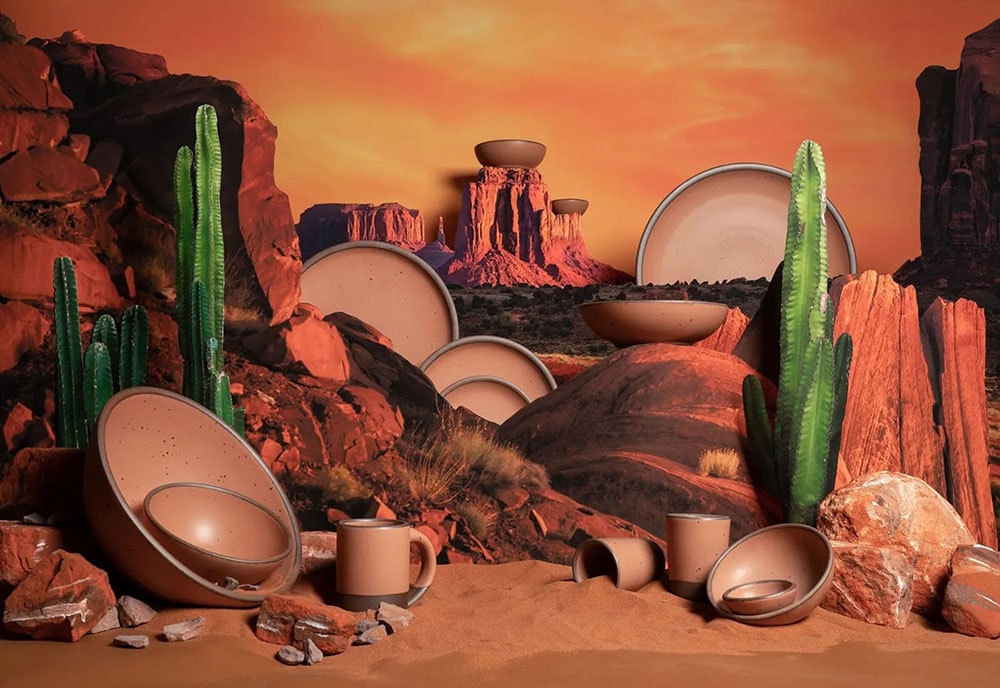

For your own product photography, you want to consider the stories that your products may evoke.
Show off your product variations
For products that come in more than one style or color, you can use a single photograph to show the breadth of your offering.
Not only does it compress this information into a single readable image, but the product colors will be easier to understand in relation to each other in the same moment with the same lighting.
This image from TKEES does a great job of drawing focus to the different shades of their strappy sandals, with a muted background and a supportive yet indefinable prop.

By adding this type of image to your product and collection pages, you can make clear to shoppers that there is a variation there for them.
Use reflective surfaces
Reflective surfaces aren’t only for gazing back at ourselves approvingly. They also add visual flair when paired with the subject of a photograph.
In this example from Aarke, the counter is clean and buffed to show the reflection of their line of carbonators, three of which are themselves beaming with reflectivity.
The reflection expands the footprint of the product and brings in a slight symmetry which is pleasing to the eye.
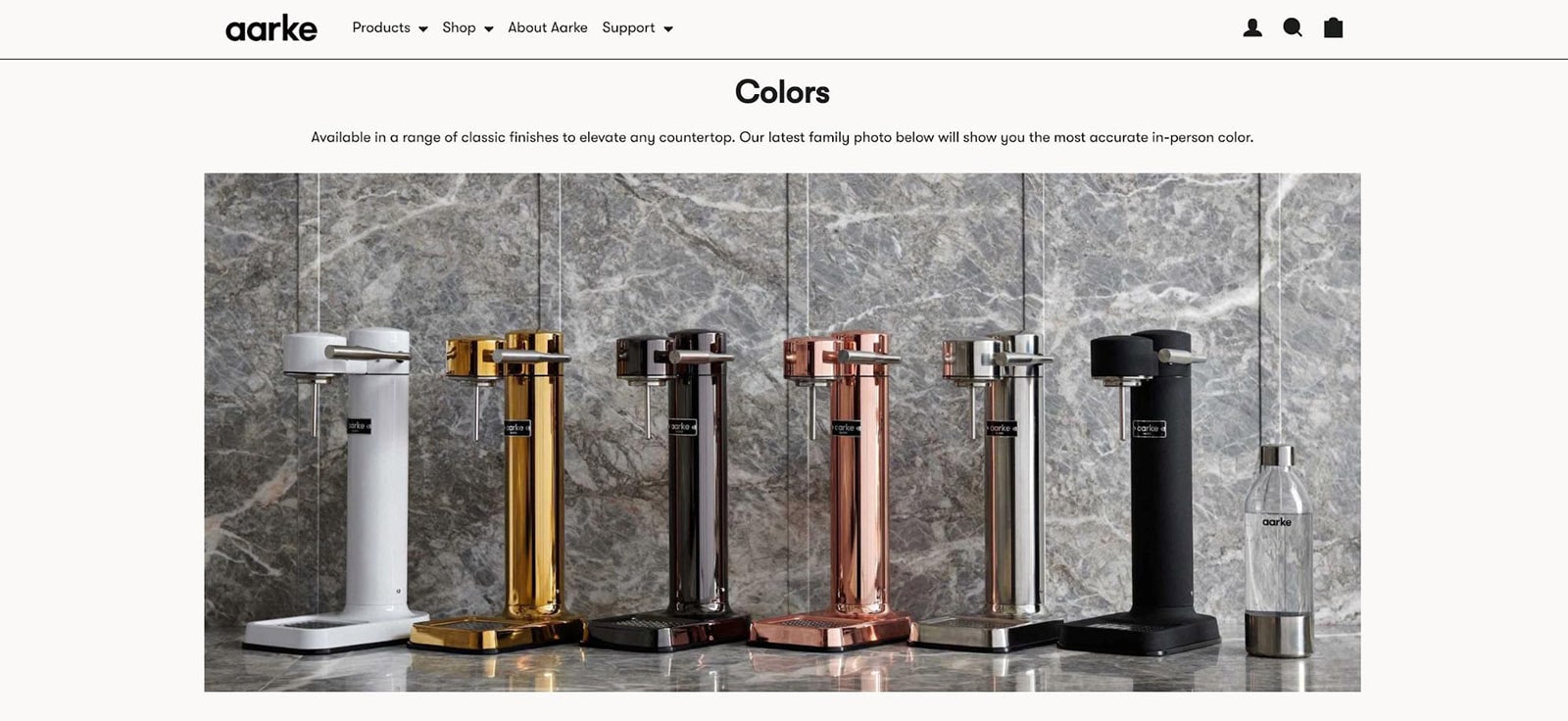
You can use reflective surfaces like this to create images that cast your product as the hero.
Make it move with GIFs
Your product isn’t frozen in time. By showing how it moves, you can demonstrate elements about it that still images alone cannot.
That doesn’t mean you have to use video for everything (though adding video to your store is a great idea too). You can use a GIF to illustrate a simple scene.
For Copper Cow, being able to simply capture their product in motion was essential. Many shoppers may not be familiar with how to brew their coffee, so they show it clearly in a looping GIF.
If a picture is worth a thousand words, a GIF is worth a few thousand, at least.
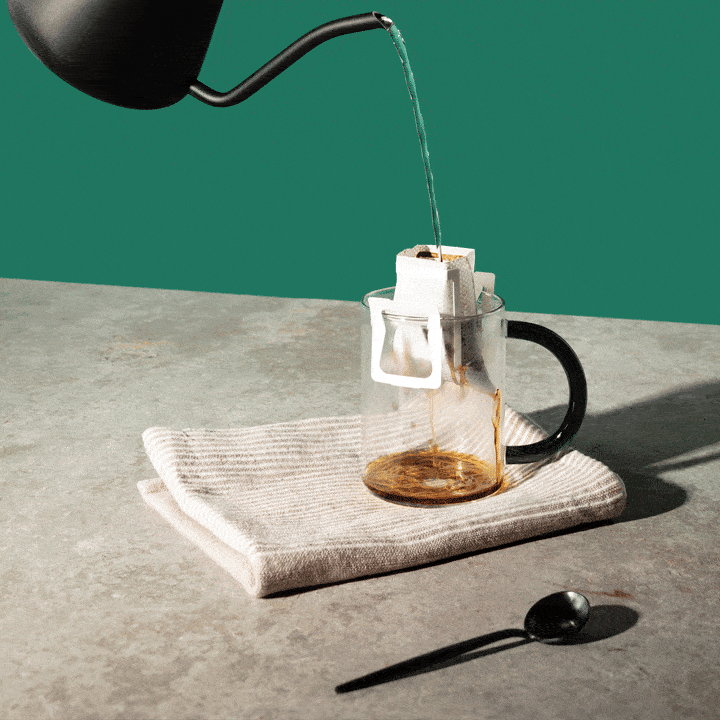
Seeing the GIF, you understand how the product works and could probably do it yourself.
Ask yourself if your product could benefit from this type of treatment.
Pair products with models
Humans are drawn to images featuring other humans.
PANGAIA is all about people. Their simple and comfy clothing is paired with models of all different types (age, gender, ethnicity, size) to demonstrate what their apparel might look like on the customer.
Their product pages even supply the model’s height and the size they are wearing.
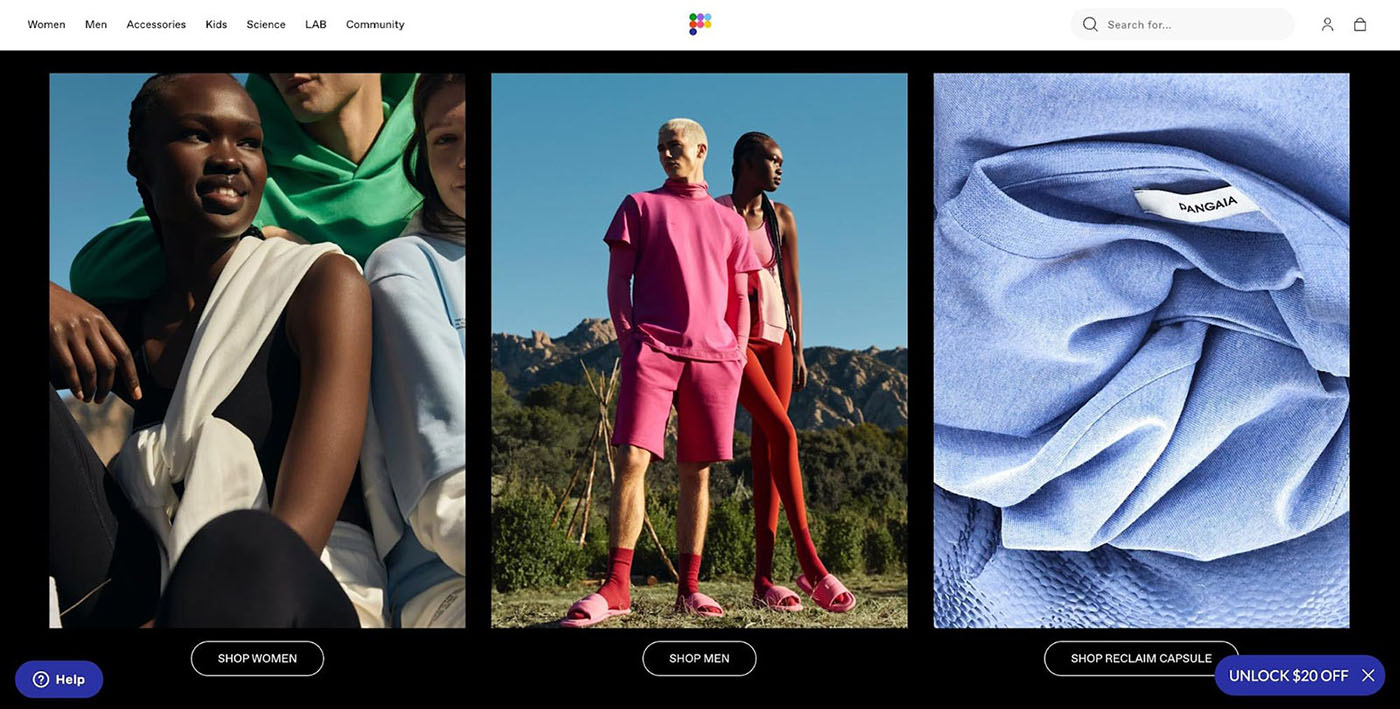
Even outside of apparel, including models interacting with your product will show how the product will fit into the customer’s life.
#cta-visual-pb#<cta-title>Customize your store with powerful images<cta-title>Create high-converting store pages that look as good as these Shogun-built stores.Design your pages now
360-degree photos
While online shopping is super convenient, it still lacks some of the benefits of shopping in person—such as picking up a product and turning it around in your hands.
To start to bridge the gap while staying online, there are 360-degree photos. Essentially, this is a GIF or small looping video that shows a product from all angles, all in one image.
This image from Mahabis is the perfect example of this strategy. While you can’t touch the shoe, you get a more complete sense of how it looks and how it’s constructed.
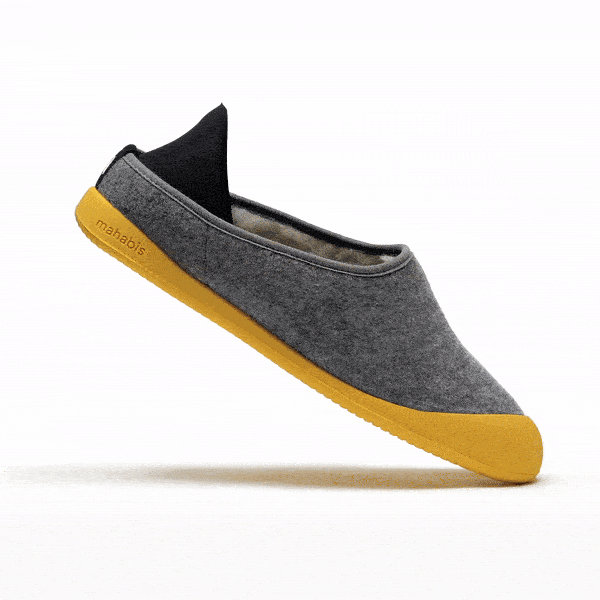
With 360-degree photos, you can give your shoppers a chance to take your products for a digital spin and show off the many sides of your goods.
Display product ingredients in isolation
Products are more than the sum of their parts, but their ingredients are key to a customer’s purchasing decision.
For that reason, it’s smart marketing to show those ingredients in isolation.
By taking high-quality photos of each product component or ingredient and displaying them together, you can show the variety that it contains.
This example from OLIPOP simply and vividly illustrates what their healthy soda contains and how it differs from typical soda offerings.
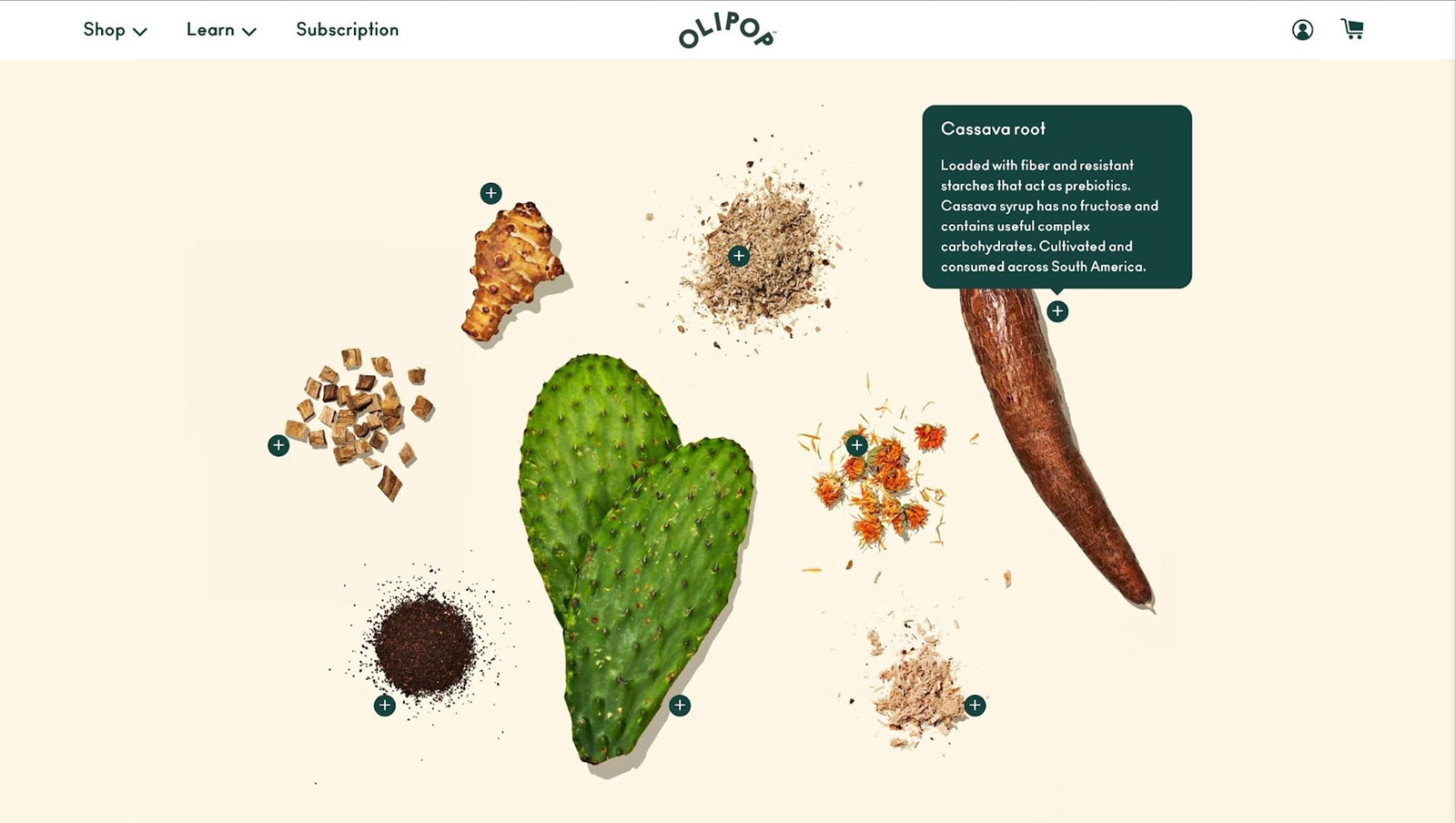
This can be a powerful yet simple project to boost your product marketing.
Make it float
While your products may not typically fly, you can use the power of photo editing to make it defy gravity.
No need to place your product on a pedestal when you can make it float instead.
In another example from Mahabis, one of the many images in their product gallery is of their shoe hovering in a white void, the slightest hint of a shadow below it.

One might imagine their foot within the slipper as they are about to make footfall (gracefully, of course).
Integrate brand humor and personality
A brand’s personality must come through in every piece of copy and every image they create, developing a consistent image no matter how shoppers find them.
Many brands use humor and wit to win the hearts of their customers.
Such is the case with The Cheese Geek. They show their personality and humor in their product photos, which they spend considerable time to stage.
In these photos for the beer and cheese pairings, the food and drink are taking a trip to the beach with surfboards in tow.
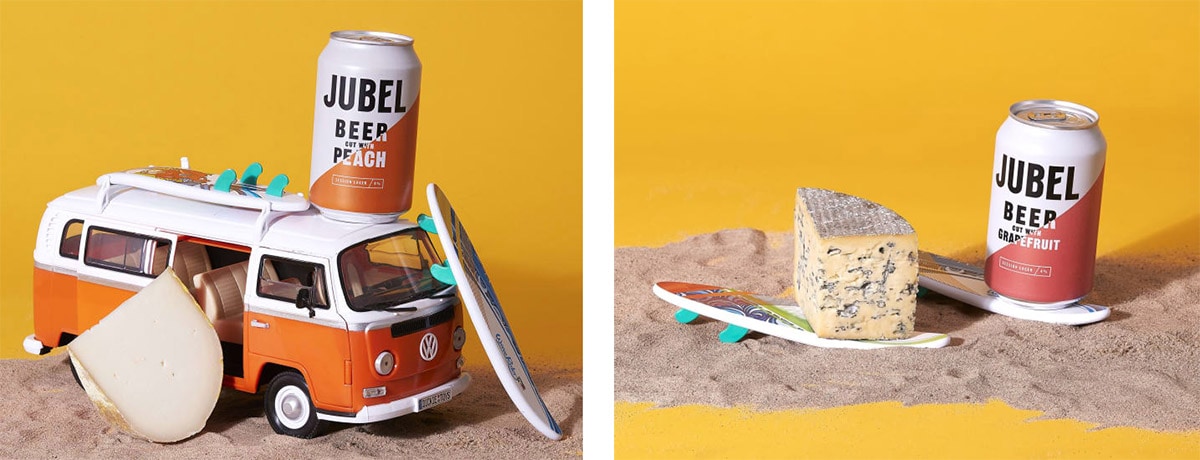
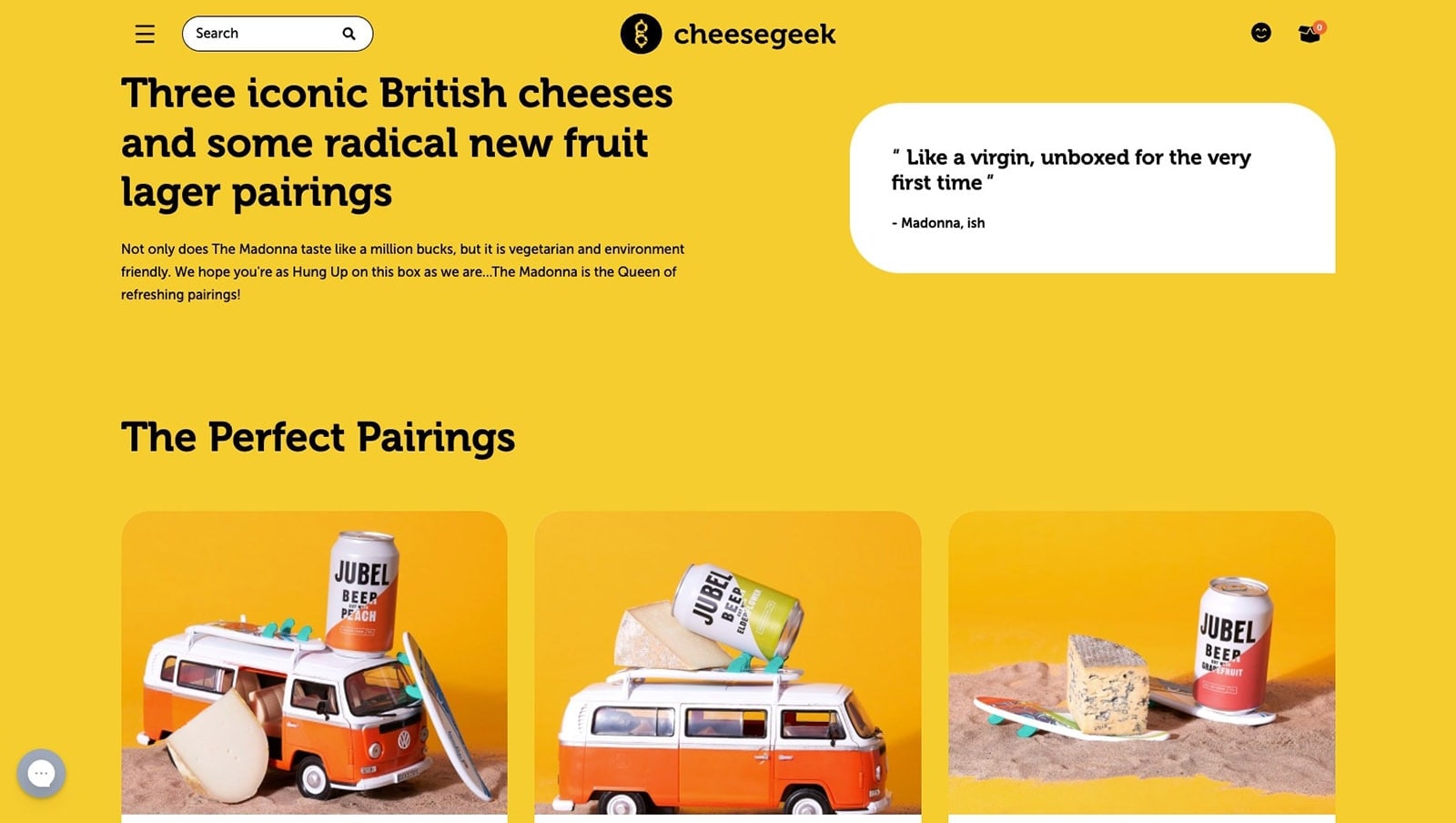
This product bundle is called The Madonna and they include a fake quote attributed to the pop idol alongside their humorous product photos.
Use the product’s natural setting
It’s helpful for shoppers to see how a product would look in a typical setting, something like their own home or in their day-to-day life.
Lifestyle photography is powerful because it doesn’t isolate a product on a solid background—it distinguishes a product by showing it in relation to everything else it may encounter.
In the case of LAY LO dog beds, that means in a home with a dog plopped sleepily atop it.
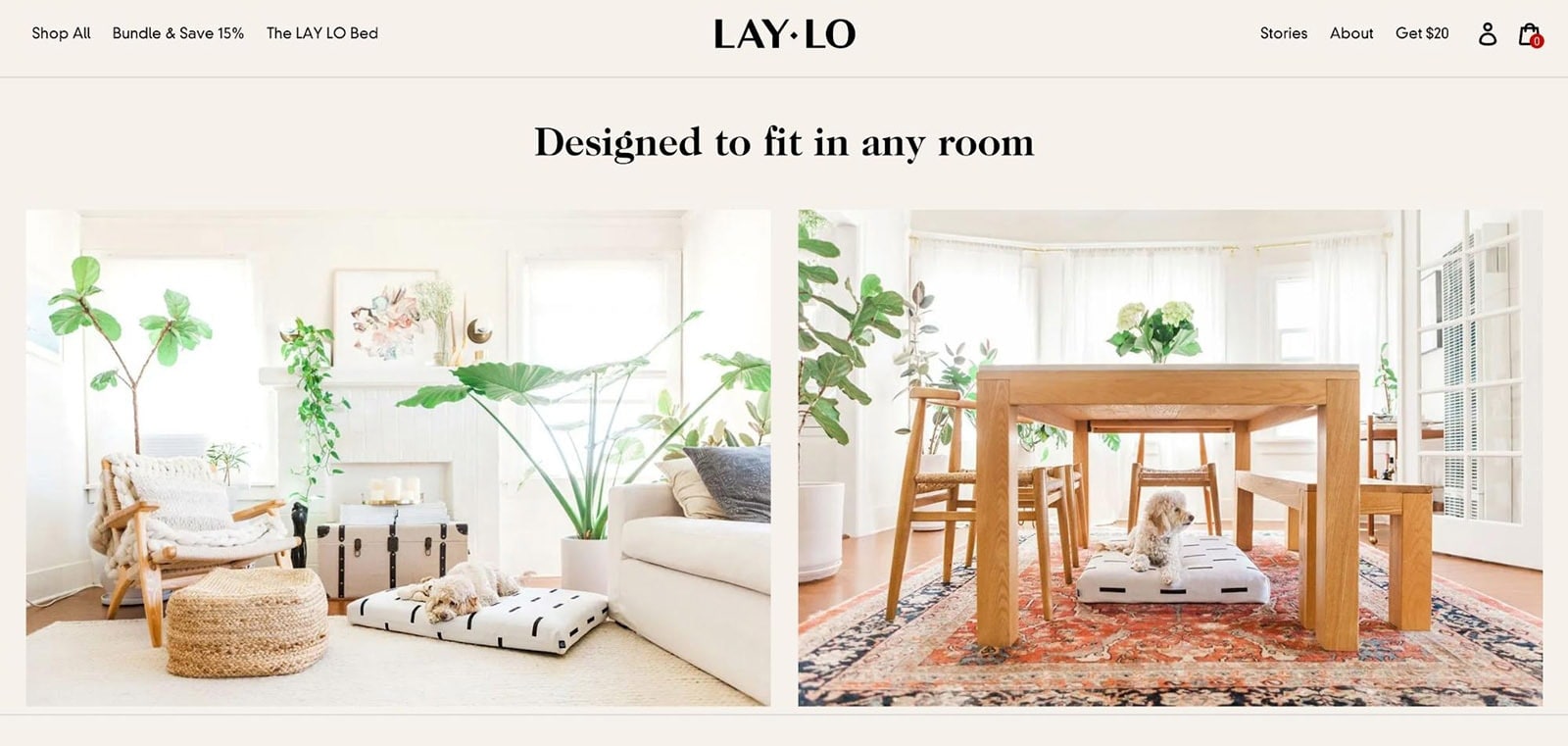
Where isolated photos are great for showing detail, lifestyle photos give products situational depth, helping shoppers imagine them in their own lives.
Take advantage of user-generated content
Once you’ve built a loyal customer base, you can start leveraging their photographical skills to your marketing advantage.
People are already taking loads of photos of incredible things. As a brand, you can guide your customers’ cameras toward your own products for use in your product marketing.
Barebones Living sources tons of beautiful photos from their customers by asking them to tag their brand for a chance to be featured on the Barebones Living Instagram feed.
The brand enjoys a pipeline of customer photos, which they can then use on their Instagram feed and on their online store. The customers then get bragging rights for being featured.

Creating a user-generated content program for your brand can help you build relationships with your customers and boost your marketing efforts.
Explore the macro setting
When trying to show off your product, you want the focus to be squarely on the product.
With the macro setting on a camera, you can dramatically feature your product in the foreground while pushing everything in the background back out of focus.
You still get the benefit of your background’s color palette, which helps to set off your product’s colors, but without the details that might draw eyes away from the star of the show.
Mancave does this with many of their product photos. You can see that their shower gel is out in the elements but the setting stays secondary to the product through the photo’s shallow focus.
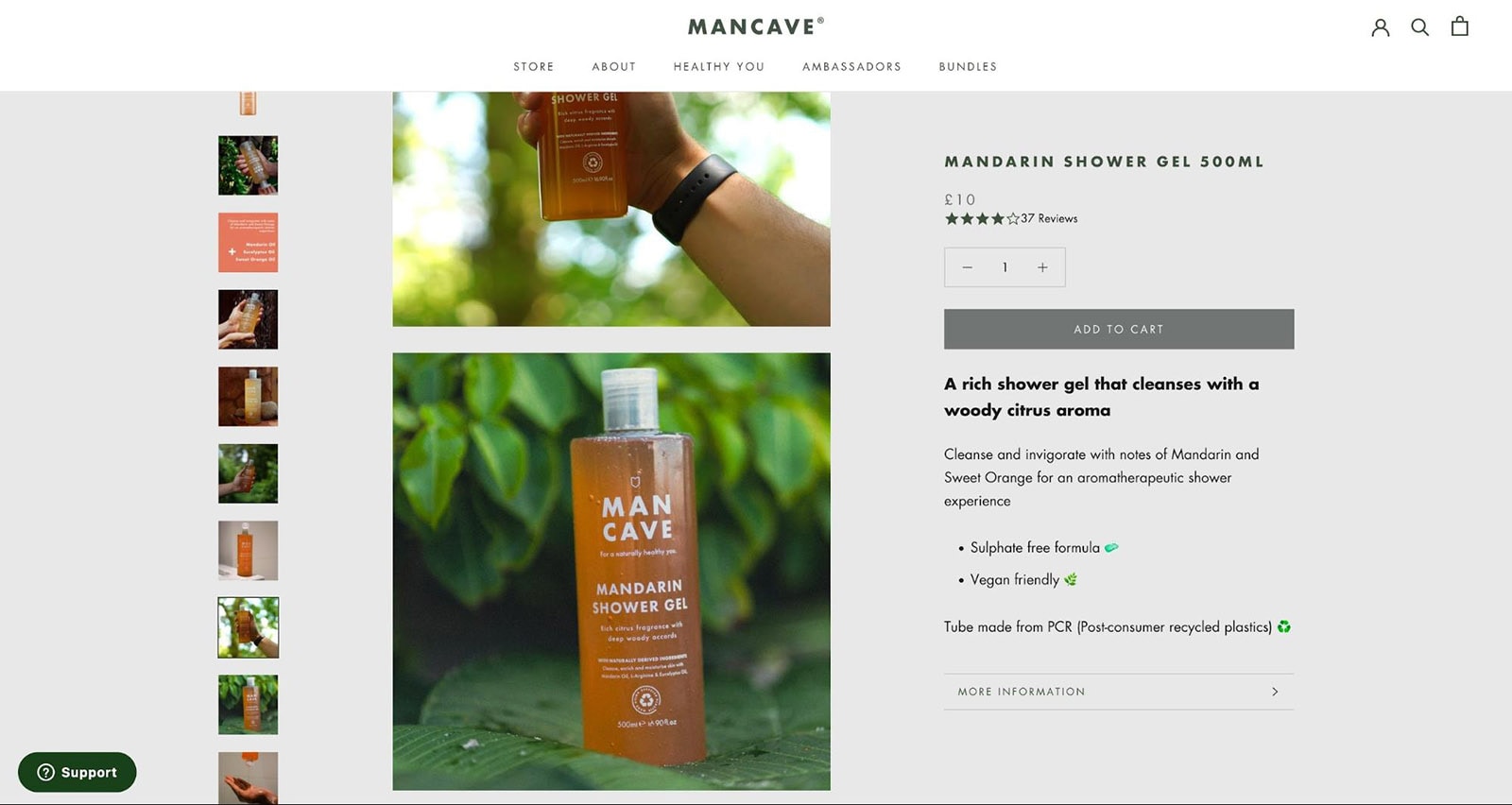
How dramatic you make each shot is up to you, but this is a great strategy for singling out your product features without sticking it in front of a solid color background.
Flat lay photography
This type of photo became popular for capturing an assemblage of items, such as a carefully positioned array of food or an accounting of what someone always carries with them.
Everyday carry (EDC) is a movement centered around the collection of objects one keeps on their person each day—things like a wallet, phone, pocket knife, keys, etc. As you might expect, EDC is all about flat lay photography.
Ridge is a big player in EDC and flat lay is one way they show off their selection of everyday objects.
In this example, the header image for their new products collection page simply displays several of their products ready to be placed back in someone’s pockets to meet the day.
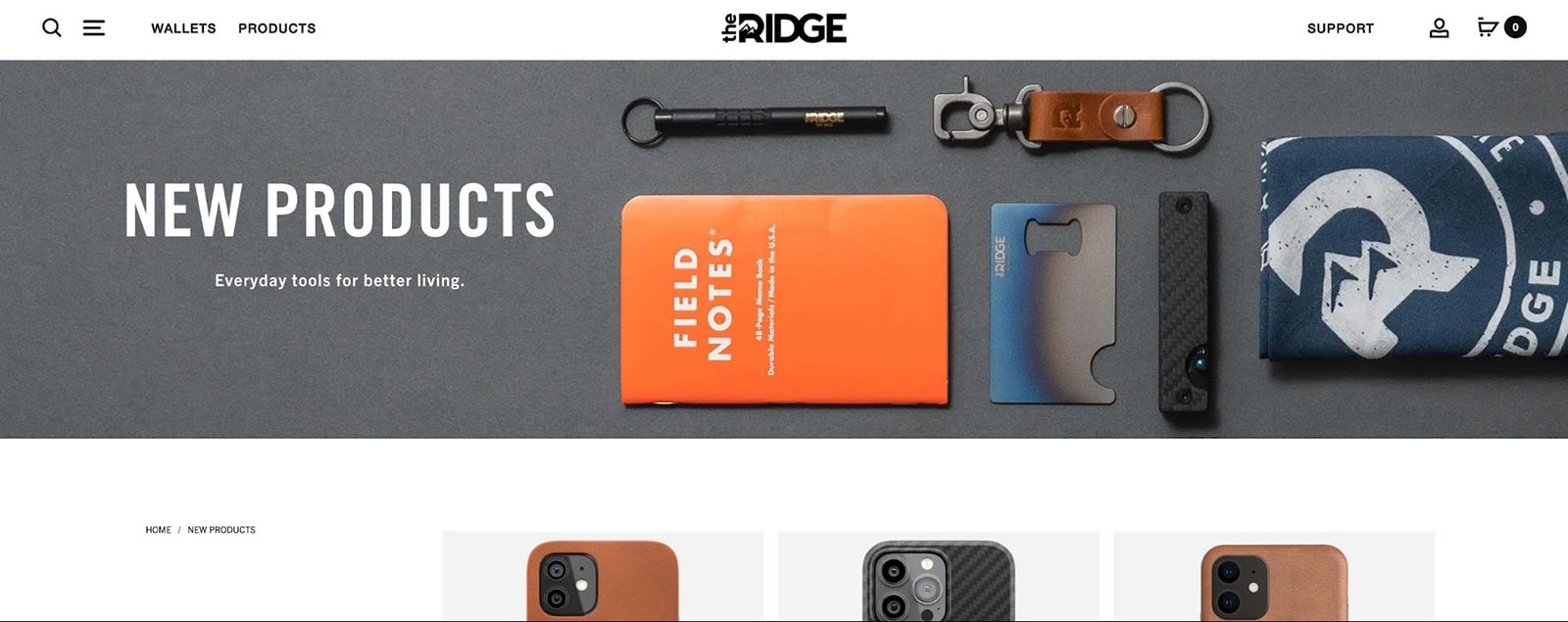
There are plenty of product niches that this could work for—coffee, packaged food, ceramics, jewelry, kitchenwares, and more.
Just find a simple flat surface on which you can carefully place your products and take your picture from a bird’s eye view. It’s not only for Instagram images of brunch, you know.
Show every angle
To get the full picture of your product, your shoppers need to see it from various perspectives. A single (possibly flattering) angle doesn’t give people enough information to inform their purchasing decision.
It’s better that they have the full view than to return it later for not being what they thought it was.
In another example from Brevitē, the image gallery explores the product in isolation from every angle, letting shoppers flip through—virtually spinning the product.

Your product image gallery should be full with added detail for your shoppers. Without these details, your conversion rates are certain to languish.
Give your products the best chance at selling
Hopefully you’ll take away some creative photography ideas from this post to use in your online store.
Serving up great photos of your products will help engage your visitors and increase your chances of a sale. You can use this great imagery throughout your store for a consistently vibrant shopping experience.
#cta-visual-pb#<cta-title>Add gorgeous photos to any store page<cta-title>Customize store pages quickly and include your product photos throughout your store to drive conversions.Start customizing today

Sean Flannigan
Sean is one of Shogun's tireless content marketers. When he isn't creating exciting ecommerce content, he's probably biking or at the park.



